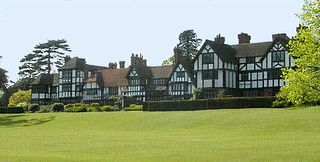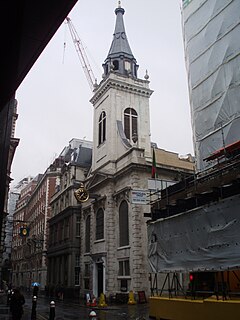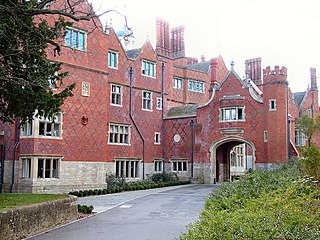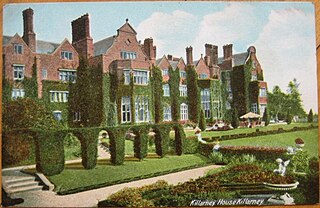
William Charles Frederick Grover-Williams, also known as "W Williams", was a British Grand Prix motor racing driver and special agent who worked for the Special Operations Executive (SOE) inside France. As a racing driver, he is best known for winning the first-ever Monaco Grand Prix and as an SOE agent he organised and coordinated the Chestnut network, before being captured and executed by the Nazis.

Eythrope is a hamlet and country house in the parish of Waddesdon, in Buckinghamshire, England. It is located to the south east of the main village of Waddesdon. It was bought in the 1870s by a branch of the Rothschild family, and belongs to them to this day.

George Devey was an English architect notable for his work on country houses and their estates, especially those belonging to the Rothschild family. The second son of Frederick and Ann Devey, he was born and educated in London.

Cottingham is a large village and civil parish in the East Riding of Yorkshire, England with average affluence. It lies 3+1⁄2 miles (5.6 km) north-west of the centre of Kingston upon Hull, and 6.2 miles (10.0 km) south-east of Beverley on the eastern edge of the Yorkshire Wolds. It has two main shopping streets, Hallgate and King Street, which cross each other near the Church of Saint Mary the Virgin, and a market square called Market Green. Cottingham had a population of 17,164 residents in 2011 making it larger by area and population than many towns. However, it is one of the villages claiming to be the largest village in England.

Charles Francis Annesley Voysey was an English architect and furniture and textile designer. Voysey's early work was as a designer of wallpapers, fabrics and furnishings in a Arts and Crafts style and he made important contribution to the Modern Style, and was recognized by the seminal The Studio magazine. He is renowned as the architect of several country houses.

Brantingham is a village and civil parish in the East Riding of Yorkshire, England, about 2 miles (3 km) north of Brough, 12 miles (19 km) west of Hull and north of the A63 road. The 2011 UK Census gave the parish had a population of 370, marking a decrease from the 2001 UK census figure of 410. The 2019 estimate was 319.

Smithills Hall is a Grade I listed manor house, and a scheduled monument in Smithills, Bolton, Greater Manchester, England. It stands on the slopes of the West Pennine Moors above Bolton at a height of 500 feet, three miles north west of the town centre. It occupies a defensive site near the Astley and Raveden Brooks. One of the oldest manor houses in the north west of England, its oldest parts, including the great hall, date from the 15th century and it has been since been altered and extended particularly the west part. Parts of it were moated. The property is owned by Bolton Metropolitan Borough Council and open to the public.

Frederick Orpen Bower FRSE FRS was an English botanist. He was elected a Fellow of the Royal Society in 1891. He was awarded the Gold Medal of the Linnean Society in 1909 and the Darwin Medal of the Royal Society in 1938. He was president of the British Association in 1929–1930.
Elkington is a civil parish in the East Lindsey district of Lincolnshire, England. It comprises the village of South Elkington, and the hamlets of North Elkington, Boswell, and Thorpe, and is situated approximately 3 miles (5 km) north-west from the market town of Louth.

St Edmund, King and Martyr, is an Anglican church in Lombard Street, in the City of London, dedicated to St Edmund the Martyr.

Goldings Estate is a large Elizabethan style country house and surrounding land close to Waterford, north of Hertford, Hertfordshire, England. The house was designed by George Devey (1820–1886), constructed between 1871 and 1877, and is a Grade II* listed building.

Francis Orpen Morris was an Irish clergyman, notable as "parson-naturalist" and as the author of many children's books and books on natural history and heritage buildings. He was a pioneer of the movement to protect birds from the plume trade and was a co-founder of the Plumage League. He died on 10 February 1893 and was buried at Nunburnholme, East Riding of Yorkshire, England.

Killarney House is an Irish country home in Killarney, County Kerry, which was built as a replacement for Kenmare House (1726) as the seat of the Earls of Kenmare. The site was chosen by Queen Victoria on her visit to Ireland in 1861.

The Rosslyn Hill Unitarian Chapel is a place of worship in Hampstead, London. It is a member of the General Assembly of Unitarian and Free Christian Churches, the umbrella organisation for British Unitarians. It is also a Grade II Listed building.

Orchard Park Estate is an area or housing estate situated on the north-western side of Kingston upon Hull, England.

Cliffe Castle Museum, Keighley, West Yorkshire, England, is a local heritage museum which opened in the grand, Victorian, neo-Gothic Cliffe Castle in 1959. Originating as Cliffe Hall in 1828, the museum is the successor to Keighley Museum which opened in Eastwood House, Keighley, in c. 1892. There is a series of galleries dedicated to various aspects of local heritage, and to displaying the house itself, which is a Grade II listed building. Entrance to the museum is free of charge.
The High Sheriff of Kerry was the British Crown's judicial representative in County Kerry, Ireland from the 16th century until 1922, when the office was abolished in the new Free State and replaced by the office of Kerry County Sheriff. The sheriff had judicial, electoral, ceremonial and administrative functions and executed High Court Writs. In 1908, an Order in Council made the Lord-Lieutenant the Sovereign's prime representative in a county and reduced the High Sheriff's precedence. However the sheriff retained his responsibilities for the preservation of law and order in the county. The usual procedure for appointing the sheriff from 1660 onwards was that three persons were nominated at the beginning of each year from the county and the Lord Lieutenant then appointed his choice as High Sheriff for the remainder of the year. Often the other nominees were appointed as under-sheriffs. Sometimes a sheriff did not fulfil his entire term through death or other event and another sheriff was then appointed for the remainder of the year. The dates given hereunder are the dates of appointment. All addresses are in County Kerry unless stated otherwise.

George Manners Astley, 20th Baron Hastings, 10th Baronet Astley became the heir to the Hastings barony upon the death of his unmarried brother in 1875.

Baronscourt, Barons-Court or Baronscourt Castle is a Georgian country house and estate 4.5 km southwest of Newtownstewart in County Tyrone, Northern Ireland, and is the seat of the Duke of Abercorn. It is a Grade A-listed building.

British Queen Anne Revival architecture, also known as Domestic Revival, is a style of building using red brick, white woodwork, and an eclectic mixture of decorative features, that became popular in the 1870s, both for houses and for larger buildings such as offices, hotels, and town halls. It was popularised by Norman Shaw (1831–1912) and George Devey (1820–1886).


















